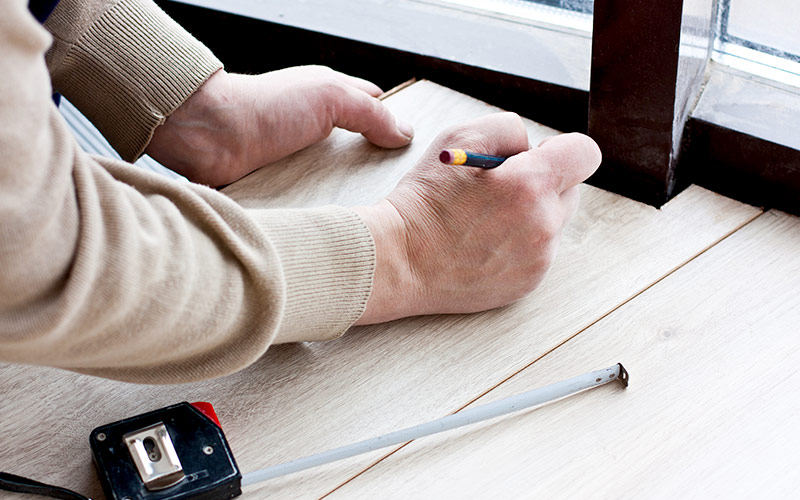Never walk on your laminate flooring for at least 24 hours following installation, no matter how inviting it looks.
Walking on your laminate flooring too early let’s just one of many honest but frustrating mistakes that people make when installing this flooring solution. In this article, we will highlight some of the biggest mistakes you can make when installing laminate flooring.
1. Not sealing laminate joints in water sensitive areas
Laminate flooring products are recommended for residential areas such as kitchens, living rooms, dining rooms, and bathrooms however following special installation instructions is required when installing laminate flooring in wet areas. In most cases laminate flooring surface is resistant to water, however, it is very important to prevent water or moisture from getting under the floor.
All ”wet” areas must be sealed with laminate flooring sealant or 100% mildew-resistant silicone to avoid moisture damage and buckling.
2. Not inspecting all the planks
Every laminate flooring plank should be fully inspected before you install them to make sure they have no visible defect and match in color, style, and pattern to the rest of the floor planks.
When you’re on your hands and knees installing flooring, it’ll be difficult to notice any defects or any damage to the laminate until you’ve nearly finished the work.
Also from a returns perspective if you find a series of defective planks after you’ve laid down three boxes of laminate negotiating the returns provider of your materials will be increasingly difficult.
3. Not allowing the flooring to acclimate
This is one of the most common mistakes people make when installing laminate flooring themselves.
Such a simple step can be extremely frustrating when you forget it and end up with a large bump in the middle of your room and have to tackle all the installation of the floor all over again.
If you bring laminate flooring from a corner into a warm environment and install it right away, the recommended expansion gaps will have to change. Experts will tell you to let your flooring sit for 48 hours in the new temperature to allow us to acclimatize.
4. Using the caulk around door jambs, pipes, and stonework
Take your time to finish your work the right way. Undercut doorjambs, trim properly to have a nice and polished look.
5. Tap laminate only if manufacturers allows to do it
New generation laminates are constructed to “click” together. There is no need– unless directed in installation instruction to use a tapping block. By hammering planks together you will damage the locking system and your floor will not lock properly.
6. Installing on uneven sub-floor
The quality of your sub-floor plays a very important role in laminate flooring performance. Many older houses have imperfect sub-floor and installing too thick laminate will be just the wrong decision. What will happen? Your laminate floor will flex up and down, adjusting to your uneven sub-floor, and the end effect will be a damaged locking system, micro-gaps between boards, and poor floor performance. An ideal situation is when you can check your sub-floor quality before laminate flooring purchase and then make an adequate decision. Installing thicker laminate will add value and durability but what is most important it will add strength to the locking system. But if your sub-floor has major problems, do not expect that underlayment and 10mm thick laminate will take care of it. Unfortunately, you have to fix your sub-floor first to fully enjoy your new floor investment.
7. Wrong underlayment choice
Laminate flooring requires an underlayment to be installed prior to the floor covering installation. This is mostly to help your floor to “float” as well as protect your floor against noises when walking on it. There are several underlayment choices on the market, but the most important thing you should now is to install vapor barrier underlayment when installing laminate flooring over concrete sub-floor as well as over crawl space, in manufactured houses, vinyl installed over concrete, ceramic tile installed over cement sub-floor, radiant floor. Vapor barrier underlayment will protect your floor against normal water vapor that is emitted through concrete. When installing it remember to overlap each row of vapor barrier laminate and add 8” overlap at seams, installed up to the edge of the wall base or wall. If you have laminate with pre-attached underlayment all you need is 6mil PE film often called Vapor Barrier.
We hope you can avoid the seven problems highlighted above and remember that installing laminate flooring takes a level of patience to get it right. Plan everything in advance and once it’s installed remember to walk away for the first 24 hours.

